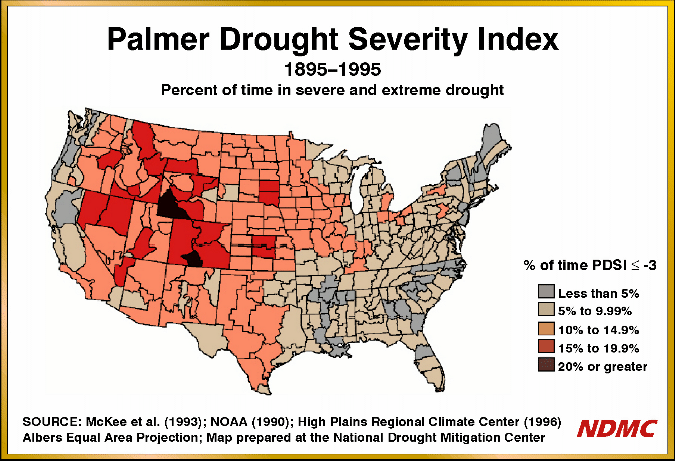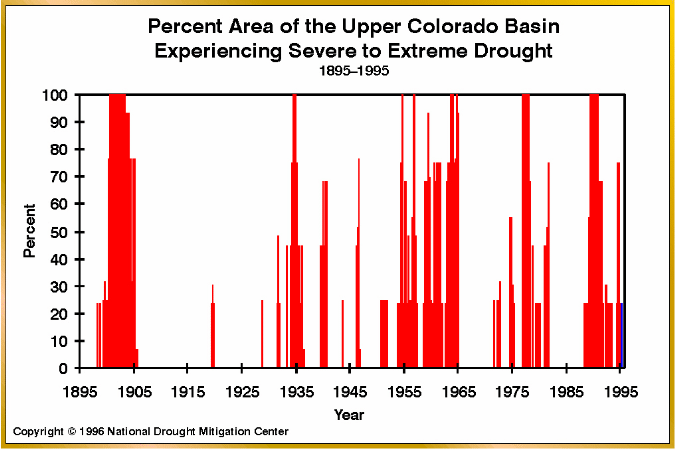Drought Cycles Plague the Western States
Nothing defines the West more than its lack of water and regularly occuring droughts. The rain giveth and the rain taketh away. Droughts in the West occur at a frequency measured at 15-20% and above (see graph below).
The current storage capacity of the the complete Colorado River System is approximately
60 million acre-feet with Lake Powell contributing very nearly one-half of this amount (27 million acre-feet). What is frightening is that the population in California, Nevada and Arizona is expected to soar from 39 million to nearly 60 million over the next 30 years. And if the Sierra Club has their way...the storage capacity of the Colorado River at the same time would be reduced by nearly 50%. Clearly, this is a recipe for disaster! We can only pray that the drought condition observed between 1895 and 1905.....never....ever...repeats itself!!

The following text is taken from the Western Governors Drought Task Force (October 1996):
"Water resource scarcity continually defines and redefines the West. Drought is common. Urban areas are growing and so are many rural areas. As a result, demands for municipal and industrial water supplies are growing. There is also a rising awareness of "quality of life" issues and concern for environmental values and related water uses. These and other changes help ensure a future where water will continue to be a primary constraint and source of conflict and controversy in the region.
Periodic drought serves to remind us that water is precious. It is imperative that we address drought in a careful and systematic manner, trying to anticipate and resolve problems and conflicts as they evolve and before they reach crisis proportions.
Drought has been an important catalyst for increasingly careful management of available water resources as new supplies are developed and water use becomes more efficient. However, an ever increasing population, shifting demands and changing trends and water use patterns, still stress existing systems' capacities and resiliency. The West is inescapably vulnerable to drought. In recent decades, the West has experienced a number of damaging and costly droughts, both economically and environmentally. Drought events reoccur in cycles. They vary in duration and intensity. The impacts can be very different. While unpredictable, droughts can be anticipated. With careful planning and management, losses can be minimized."
"In order to provide additional storage capacity in the upper basin and ensure that adequate deliveries could be made to the lower basin, as per the Colorado River Compact, Congress enacted the 1956 Colorado River Storage Project Act (CRSP). It authorized the construction of several major storage projects in the upper basin, including Glen Canyon Dam and Lake Powell, which holds 25 maf. With the completion of the CRSP units, the storage capacity in the Colorado River Basin was increased to approximately 60 maf, which went a long way toward ensuring a reliable water supply even during times of drought."

Losing Lake Powell - Water Storage Effects
The loss of Lake Powell would put a great stress on other water storage projects such as Lake Mead. Wild fluctuations in lake levels would result. During wet cycles the flooding of downstream investments would be inevitable and so would the complete drying of Lake Mead during prolonged droughts.
The Impact on Lake Mead and Downstream Users
The Coping With Severe and Sustained Drought in the Southwest - USGS
The Impacts of Droughts in General
The National Drought Mitigation Center - Why should we plan for drought?
Droughts Create Conflict
How Drought Compares with Other Natural Disasters
More Western U.S. Drought Information
Western Drought Report
Historical Droughts by River Basin
Ancient Drought Cycles Threaten Western Water Supplies
Western Resorvoirs - Historical Perspective
Western Governors, Federal Agencies Sign Drought Pact
The National Drought Policy Act of 1997
Western Drought Coordination Council
Western States Climatic Monitoring


